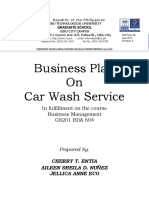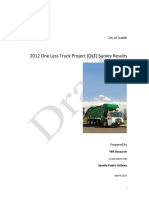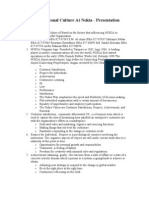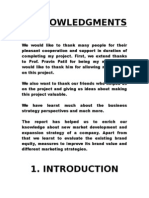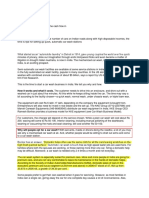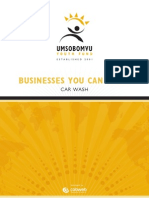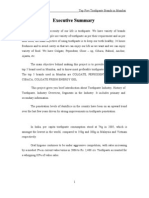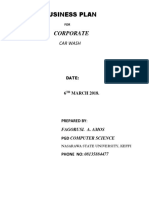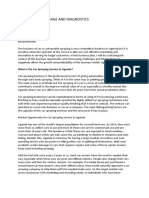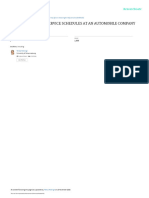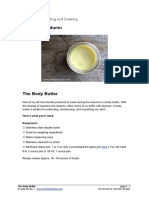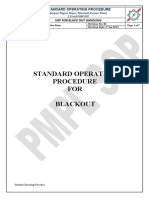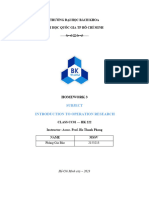Car Wash Assignment
Car Wash Assignment
Uploaded by
Tahir YaqoobCopyright:
Available Formats
Car Wash Assignment
Car Wash Assignment
Uploaded by
Tahir YaqoobOriginal Title
Copyright
Available Formats
Share this document
Did you find this document useful?
Is this content inappropriate?
Copyright:
Available Formats
Car Wash Assignment
Car Wash Assignment
Uploaded by
Tahir YaqoobCopyright:
Available Formats
Exit report for the
Car Wash Water Saver Rating Scheme
a joint project of the
Australian Car Wash Association and the
Victorian Smart Water Fund
Submitted to Diane Ross
Australian Car Wash Committee
December 2005
Revised and Updated
May 2006
Page
Introduction 1
Project Aims 1
Key Phases 2
Attachment 1 Summary of Market Research 7
Attachment 2 Focus Group Report 10
Attachment 3 Industry Newsletter (attached .pdf) 14
Attachment 4 Invitation to Join the Scheme excluding fees (attached .pdf) 15
Separate to this report, the Scheme has a number of documents which are subject to copyright
and are confidential to members of the Car Wash Water Saver Rating Scheme. They have
been provided to the Smart Water Fund and are held by the Fund as Commercial in
Confidence submissions.
The documents include:
Invitation to Join
Invitation to Join Major Players
Application Kit incorporating
Self-Assessment
Agreement and Code of Practice
Welcome Kit incorporating
Water Conservation Plan
Best Practice Guide
Style Guide for use of Scheme logo, rating sign and promotional signage
Introduction
The Australian Car Wash Association (ACWA) was established in 1994 to provide information,
support and a communal linking for car wash owners and operators who otherwise could be quite
isolated. The Association is run by a volunteer national committee with a part time paid
administrative officer. The association offers its members technical support, facts sheets on a wide
range of topics, organisation of promotional events, and member open forums and other meetings.
ACWA represents more than 70% of all car wash sites in Australia. As the peak national body, it
can speak with government and other related organisations on behalf of the members and the
industry.
In May 2004, ACWA received a grant from the Victorian Smart Water Fund to develop, test and
launch a car wash water saver rating scheme. The initial scope of the project was confined to the
Victorian market. If the project was successful in Victoria, ACWA would then initiate a national
roll out of the scheme.
Mendleson Communication was contracted in June 2004 to develop a water rating scheme for
commercial car washes on behalf of the Australian Car Wash Association (ACWA).
This exit report provides a summary of the project requirements and the processes used to complete
the project. It aims to capture some of the observations we have made and what we have learned
through the experience of developing the documentation. We believe that this may prove useful
for future projects when consulting with similar target audiences and producing resource kits.
The report contains three sections:
a summary of the project requirements and processes used to complete the project
observations on how the process could be improved in future, similar projects
an appendix which contains key reports and documents developed during the project which
contain the key learnings and outcomes of the project.
Project Aims
The primary aims of the car wash water saver rating scheme project are to:
help protect the viability of the car wash industry in times of water shortages through the
creation of responsible water standards
educate consumers to make informed decisions about commercial car washes.
The car wash water saver rating scheme project is aimed at reducing the volume of potable
(drinkable) water used at commercial car washes by promoting efficient water use and practices.
It is envisaged that the scheme will drive the market to develop cost-efficient technologies to
support the needs of the car wash industry. It is also expected that the scheme will educate current
car wash customers to demand efficiency in water usage. A side effect of the project will be the
general public gaining an increased understanding of the water efficiency of commercial car
washes.
The car wash rating scheme will be self regulatory and will establish industry standards for water
consumption and the methods to achieve it.
Page 3
Key Phases
The project was split into five key phases:
1a. Planning
1b. Feasibility (initial market research)
2. Development
3. Testing (pilot scheme)
4. Launch and Marketing
5. Review and Evaluation to follow 6-12 months after project completed.
1a. Planning
In the planning phase Mendleson Communication developed a detailed project plan which set key
actions, milestones and a budget for the project.
1b. Feasibility (initial market research)
In order to assess the feasibility of developing and implementing a water rating scheme for car
washes, market research was conducted to develop an understanding of the target audiences
attitudes and perceptions.
Market Research Purpose
The primary purpose of undertaking the initial market research was to determine if a car wash
rating scheme would influence consumer and industry behaviour and result in potable water
savings. The project plan was then adjusted to reflect the market research findings.
Research Methodology
A combination of qualitative and quantitative research methods were used to achieve the market
research objectives:
telephone survey of 200 car owners in the general public conducted by the Market Research
Agency.
survey of 200 current car wash customers on-site conducted by car wash managers/staff. This
was split between a mix of regional and metropolitan car washes in different areas as
determined by the Project Manager in conjunction with the project committee.
20 in-depth interviews with individual car wash owners conducted by the Project Manager
comprising:
split of 8 face to face interviews and 12 telephone interviews
split of 10 rural and 10 metro car wash operators
mix of small and large car wash operators.
Research Results
Market research concluded:
The proposed water efficiency rating scheme has the potential to affect about a third of
vehicle owners in their choice of commercial car washes, and could become an important
factor influencing their choice of car wash. Hence the proposed scheme is likely to
encourage the use of more water efficient car washes by a significant proportion of car wash
users.
Informing and convincing existing car wash users that commercial car washes are water
efficient and having environmental benefits will be worthwhile as this could cause up to 15%
of existing customers to use commercial washes more often in the future.
Page 4
There is also considerable potential to increase the number of car owners using commercial
car washes, which would reduce water wastage from home washing. Only about a third,
35%, of car owners currently use commercial car washes for the majority of their vehicle
washes and only 40% of car owners are aware that commercial washes can be more water
efficient. If car owners can be informed of the water efficiency of commercial car washes,
this could influence up to a further 8% of car owners in their decision to use commercial car
washes in the future.
Operators need to be made more aware of the threat to their operations from water shortages
and that self-regulation of the car wash industry is more likely to obtain the support of the
water industry during these times. 20% to 30% of operators accept supplier or industry
figures as the basis of their water consumption rather than measuring and evaluating it
themselves, which indicates that water consumption is not being taken seriously enough in
some parts of the industry.
The ability of many operators to adjust their water consumption may be relatively limited,
particularly for self-serve facilities. The use of recycled water needs to be further examined
and the reality of quality and business barriers to adopting recycling determined. These
issues could affect the technical potential of car wash operations to achieve water efficient
standards, and hence limit the viability of the scheme.
Measurement of water consumption may be an issue for the proposed water efficiency
scheme. The majority of operators are not accurately measuring their water consumption per
wash. There will be a need to establish a reliable and straightforward way of measuring
water consumption for all types of car wash facility and to train operators in its use.
The research indicates that the proposed scheme would be joined by the majority of operators
and the fact that 75% wish to participate in the scheme trial is a good sign.
The Summary of market research findings is Attachment 1 to this report.
2. Scheme development
Scheme development tasks included:
engaging technical consultants
finalising rating scale
developing, documenting and finalising accreditation criteria
determining self funding fee structure
finalising audit and compliance structures
engaging scheme auditors
launching the scheme to the Victorian car wash industry.
It took a full twelve months to develop and test the methodology and documentation which would
form the basis of the Car Wash Water Saver Rating Scheme. The underlying aims were:
to build a rating system which would be easily understood by customers
to develop an assessment process which could be undertaken by the owner/operator, in order
to save time and costs, and to keep the assessment current with upgrades and changes to the
site
to ensure that the assessed rating was accurate and independently auditable, so that both
water regulators and the public had confidence in the scheme and the signage displayed
The Invitation to Join the Scheme is Attachment 4. The Scheme documents are copyright and
confidential to members of the Car Wash Water Saver Rating Scheme. They are contained in the
folder submitted with this Exit Report see Index on Page 2 for the list.
Page 5
3. Testing (pilot scheme)
The scheme was then tested using 5 sites, with a mixture of metropolitan and regional sites. The
pilot went from June to November 2005 and tested the following elements:
signage
market research amongst consumers that tested their reaction to the scheme. This was very
positive and strongly reflected the market research conducted during the feasibility stage.
a focus group with car wash operators testing their reaction to the scheme, including overall
concept, proposed fees, signage and logos. Generally, the results were supportive of the
scheme. They also indicated that open meetings with the operators could be the best way to
promote the concepts and value of the scheme, including correcting false ideas (for instance
this is an industry scheme not an ACWA scheme, open to all).
The focus group report is included as Attachment 2 to this document.
Pilot sites and a number of additional sites were also asked to thoroughly test and comment on the
self assessment procedures designed so that car wash owners can calculate their own preliminary
rating, which would later be confirmed by the scheme manager and auditors.
4. Launch and Marketing
As the scheme was developed, the industry was kept informed by articles in the national ACWA
Newsletter and the Australian Convenience Store News. In September, a 4-page newsletter
(Attachment 3) was prepared by the project manager and sent to all car wash owners nationally,
informing them about the scheme, how it would work and the benefits of joining.
The scheme was officially launched on 18 October 2005. Mendleson Communication coordinated
a picture opportunity which featured people from ACWA, water authorities and the Smart Water
Fund and circulated a media release. Coverage was obtained in local and water industry media.
In November, a direct mail Invitation to Join was sent to all Victorian car wash owners
encouraging them to join the scheme and offering them free signage if they applied for the self-
assessment test by mid-December. In response to this mailing, ACWA received approximately 20
registrations prior to the end of the calendar year.
Additionally, in December, members of the project committee met with representatives from
Mobil, Caltex, Coles Express and BP. All meetings have been positive and all are considering
joining the scheme. Caltex intends to start with their Victoria sites early in 2006 and the other three
have further meetings set up to work towards a schedule of joining.
The water regulators were also kept informed during the development of the project, both by a
series of letters and information flyers and in a national workshop convened in Queensland at the
time of the ACWA Convention in early August. These communications have been followed up by
on-going meetings and correspondence with water regulators all over Australia.
Page 6
5. Review and Evaluation
This review covers progress to early April 2006. A second review and evaluation will take place in
December this year.
5.1 Progress with small operators
As the water situation is no longer as critical in Victoria as in 2003-2004, and regulators are not
enforcing water reductions in other states, the small operators have largely taken the view that the
need to promote and advertise water efficiencies is not a priority cost at this point in time though
verbally they still support the concept. To counter this view
the focus is being directed at self-serve facilities who do not have to invest thousands of dollars
in recycling equipment which does not yet have widespread market support;
a series of social meetings has been started with ACWA members to promote the concept of
using the scheme to grow their customer base this is a good selling tactic as most carwashes
have reduced turnover from the peak of two years ago.
5.2 Progress with major players
The dialogue is continuing with the majors, adjusting the financial structures to eliminate large up-
front fees and working out a process for self-assessment by their major equipment suppliers.
It seems that at least three of the companies feel that they must be part of the scheme and that the
process of joining is reasonable. We believe that they will sign up by 30 June 2006, each starting
with a minimum of twenty sites. Caltex has already committed and submitted a list of sites in
Victoria and south east Queensland. All four companies are in the process of upgrading and will
only bring in sites that can achieve at least a four star rating.
5.3 Comments on how the process could be improved in similar projects in the future
In this section, we have noted some of our thoughts on the project process and aimed to supply
practical comments as to how the process of developing an Industry Association based scheme
could be improved in the future.
Key challenges
One of the key challenges throughout the project was the technical challenge faced in developing
a credible, fair and auditable scheme. Car washes vary hugely across the industry in terms of:
equipment used and how it is set up
size of operations, from very small individual operators to large chains
staffing and the technical skills of staff.
The scheme will have to continue to work with operators across the industry to refine the whole
technical side of the scheme, i.e. auditing and self assessment.
Another key challenge was being able to engage the car wash operators. This proved very
difficult, even among the pilot sites who had committed their interest. A lot of time was spent by
the project manager chasing and liaising with the pilot operators and additional operators who had
agreed to comment on the self assessment test. Finding effective ways to engage the operators will
be absolutely fundamental to the success of the scheme. The state of water restrictions is very
much a driving factor in terms of attracting their interest and commitment.
Page 7
The results of the market research held both at the beginning of the project and during the pilot
process have been very positive both in terms of the overall concept of the scheme and the rating
system used. There are strong indications that a larger percentage of the wider population will be
interested in using commercial car washes if they believe that this will save water, and this can be
used as a second selling point for the scheme to the industry.
The structure of the water rating scheme committee worked very well and this was absolutely
key to the success of the project. The combination of having representatives from ACWA
(including both small and large operators), the Smart Water Fund and regulators was an excellent
combination.
Overall, the project was a much more complicated exercise than originally anticipated. It was a
much more expensive and extensive process to undertake to do it properly and to create a truly
viable scheme. Part of this was because there was no one who could give us a lot of information on
how to construct the scheme. Other ratings schemes exist, and we were able to draw some
information from them, however no precedents could be found for the technical challenges found
in assessment and auditing processes.
ACWA felt that the Smart Water Fund was too inflexible at the end as far as being open to
extending the grant. We needed at least $20,000 extra to be able to market the scheme effectively
as was originally planned as part of the project. This will not be able to happen as, in spite of a
huge voluntary time commitment from members of the project committee, all the funds granted
were used in the development process and bringing the project to completion. We recommend that
the Smart Water Fund has a contingency available to projects to allow for overruns where they
believe that the money has been well spent.
5.4 Evaluating the future success of the project
At the commencement of the project, the following targets were set as part of the initial project
plan. At this stage, it is too early to report on whether these objectives have been achieved,
however, we have noted them here to report back in December 2006..
The project will be successful if it achieves credibility in the eyes of consumers and car wash
operators, majority participation by operators, and increased awareness of the water efficiency of
commercial car washes. The following objectives are measurable factors of success of the project:
120 Victorian car wash sites to join the scheme in FY 05/06. This represents a 60% take-up.
Existing car wash users display increased awareness of the water efficiency of commercial
car washes: increase from 70% to 85% (Measures awareness)
50% of car wash customers state water efficiency is as important as other factors in their
choice of car wash (Measures behaviour)
Win approval to use the Smart Approved Water Mark for the rating scheme. This may be a
stretch target for the project, however the mark provides independent and credible
assessment of water efficiency and a national endorsement of the scheme.
Page 8
Attachment 1 Summary of Market Research
Conclusions that can be drawn from the results of the market research include:
There is considerable potential to increase the number of car owners using commercial car
washes, given that only about a third, 35%, of car owners currently use these services for
the majority of their vehicle washes. Car owners and especially car wash users are
interested in water efficiency and consider this when using a commercial car wash but only
40% of car owners are aware that commercial car washes can be more water efficient.
If car owners can be informed of the water efficiency of commercial car washes, this could
influence a further 8% of car owners to use of commercial car washes and potentially
reduce water wastage from home washing.
Even informing and convincing existing car wash users that commercial car washes are
water efficient and have environmental benefits will be worthwhile as this could cause up
to 15% of existing customers to use commercial washes more in the future.
Operators need to be made more aware of the threat to their operations from water
shortages, and if this is done they are more likely to support the move by the industry to
self-regulate. The fact that about a quarter of operators do not know their per wash water
consumption indicates that water consumption is not a major consideration in some parts
of the industry.
The use of reclaim systems needs to be further examined and the reality of quality and
business barriers to adopting recycling determined. These issues could affect the technical
potential of car wash operations to operate in a water efficient manner, hence to viability
of the scheme.
Measurement of water consumption may be an issue for the proposed water efficiency
scheme. There will be a need to establish a reliable way of measuring water consumption
and to train operators in its use, otherwise they will not be able to assess if they are
improving their water efficiency.
The proposed scheme would be joined by the majority of operators and the fact that 75%
wish to participate in the scheme trial is a good sign.
Operators should be supplied information about the scheme by newsletter and email and
kept up to date with information about reactions by the responses from public/customers
and how the scheme was to be implemented, measured and audited.
Car owners: key findings
Only about a third, 35%, of vehicle owners use commercial car washes for the majority of
their vehicle washing.
Saving water/being better for the environment were reasons mentioned by about a third of
respondents (32%) for using a commercial wash and water restrictions by a quarter
(27%).
The majority, 57%, of vehicle owners that used commercial car washes for the majority of
their vehicle washes already knew that commercial washes were more water efficient but
only 30% of less frequent users knew this.
Of those that did not know that commercial washes were more water efficient, 66% of
respondents who used the commercial washes for the majority of their vehicle washes
Page 9
stated they would be influenced by this knowledge but only 12% of less frequent users
stated they would be affected. This means 8% of car owners who currently are not
regular users of commercial car washes could be influenced by the knowledge of that
commercial car washes are more water efficient to use commercial car washes more in the
future.
The majority (54%) stated that knowledge of a car washs water efficiency rating would
affect their choice of car wash. More females, 61%, than males, 45%, stated that
knowledge of a car washs water efficiency rating would affect their choice of car wash.
Of the respondents who said they would be affected by a car washs water efficiency
rating, a large majority, 79%, stated that the water efficiency rating would be as
important as the convenience, cost and quality of the car washes in their choice of a car
wash.
The majority of respondents suggested the use of the mainstream media - radio, television
and daily newspapers - as the media to inform people, while a third also mentioned
promotion of the scheme at the car washes themselves.
Car wash users: key findings
The majority of car wash users interviewed, 75%, washed their vehicle at least monthly at
a commercial wash.
The majority of car wash users, 69%, mentioned the water efficiency/environmental
advantages of commercial car washes as one of the reasons they used commercial car
washes. However, this proportion might overstate the case as the result in the telephone
survey was much lower. Nevertheless, a significant proportion and possibly the majority
of car wash users are at least partially motivated to use commercial washes due to their
water efficiency/environmental benefits.
The present level of knowledge in car wash users is high concerning the greater water
efficiency of commercial washes, with 70% knowing this fact. These results are supported
by the telephone results. However 30% of car wash users are not aware or convinced of
this fact but half of these would be more likely to use a commercial car wash in the future
if they knew this. This indicated building awareness in the existing customer base could
contribute to up to 15% of existing customers choosing to use commercial car washes
more in the future, hence reducing water wastage through home washing.
Around a third of car wash users, 36%, stated their choice of car wash would be affected
by the proposed water efficiency rating of car washes and for about a third of car wash
users the water efficiency rating might be an important or very important consideration in
their choice of a car wash. This proportion is lower than that indicated by the telephone
survey, but it is probably a more realistic result. It still suggests the proposed scheme
could have an impact on very significant proportion of car wash customers.
The majority of respondents suggested the use of radio, suburban newspapers and the
promotion of the scheme at the car washes as the methods to inform people about the
proposed water efficiency scheme.
Car wash operators: key findings
All operators displayed a good level of knowledge about local water restrictions, however
the knowledge of the potential threat of their water being cut off by water authorities is
not sufficiently well understood by the industry.
Page 10
They are very positive about the industry taking the initiative to regulate its own water
consumption rather than have it imposed by water authorities.
The operators ability to measure their water consumption varied, with between 70% and
80% believing they know their per wash potable water consumption.
Operators achieving savings greater than 41% in automatic or conveyerised sites are
doing so through using rainwater, borewater or using a reclaim system.
A variety of methods to achieve proportionally small savings in automatic sites were
proposed by operators.
The majority of operators are recycling the discarded water from the reverse osmosis
function but this achieves less than 10 litres per wash savings.
Just under 30% of operators with automatic car washes (i.e. conveyerised hand wash,
brushes and touchless) are using reclaim systems to recycle water, and all using them are
recycling more than 41%.
About 30% of operators have the plumbing to use recycled water but have decided not to
do so. Operators not recycling water are doing so due to quality concerns and also the
lack of a business imperative.
Operators recognise that water efficiency in car washes is important to their customers,
and have perceptions regarding the importance of this to customers which are broadly in
line with the results of the telephone and car users surveys.
The majority of operators would participate in the water rating scheme if it was introduced
and the proposed fees appeared acceptable to the majority.
Operators want information about the scheme by newsletter and email and are especially
interested in information about reactions by the responses from public/customers and how
the scheme was to be implemented, measured, audited.
75% of the operators are interested in participating in any trial of the scheme.
Page 11
Attachment 2 Focus Group Report
Held 12- 1.30pm
October 25, 2005
Focus group took place at Mendleson Communication premises.
Present were: Paul Morris ACWA; Rob Bassett-Smith Carwash Springvale; Tony Stephens,
Washbusters South Yarra; Rick Turner, Ezy Wash Ferntree Gully; Daryl Bedar, Suds, Ormond;
Gary Lewin, Supa Car Wash, Glen Waverley.
Facilitated by: Anne Connor, Mendleson Communication
Notes taken by: Jen Perry, Mendleson Communication
General feedback:
The people around the table thought the scheme was a good idea and most of them supported it.
However, the general consensus was that the average car wash owner needs to be educated as to
the benefits of buying into the scheme and that the $1,000 fee could be difficult for some. They
also felt that it may be especially difficult to sell the scheme considering that we are not on water
restrictions at present.
All agreed that it should be mandatory that if you buy into the scheme, you must become a member
of the association. Otherwise, ACWA should make the fees for non members five times higher than
the fees for members.
It was also agreed that the consumer needs to be educated as to what the scheme is and what the
star ratings mean.
The general consensus was also that the committee is on the right track, has done a good job, there
just needs to be fine tuning of some of the details.
Proposed Water Saver Rating Scheme
The purpose of the scheme is to encourage:
awareness of water use by car wash customers and by the car wash industry, and
reduction in the amount of drinking water used for car washing.
The general opinion was that the public needs to be educated as to what the star rating means, as
many customers already think that they are washing their cars with recycled water. Not many
customers know that they are washing their cars with drinkable water.
Also, the public may interpret that less stars mean a cheaper wash, as in the star rating system for
accommodation.
Also the question was raised that, as a car wash operator, why would you buy into the scheme if
there arent any water restrictions on at present?
Levels of Ratings
Participants were presented with logos and what the water efficiency meant
The general opinion was that it is hard to distinguish what the stars mean. They are too hard to see.
There was also concern that the costs will go up for the consumer because of the re-structure of
equipment and costs to buy into the scheme, to qualify for a star rating.
Page 12
A general discussion took place about the assessment for a star rating as every carwash has a
different PSI and litre measurement is relevant to time.
It was also mentioned that it wouldnt be viable to buy into the scheme if you were a two star
rating, because when stages two and three of the water restrictions were on you wouldnt be able to
stay open.
The star logos were held up for the group to view and give their thoughts
There was a mixed reaction from the group. Some said they liked the logos and others said they
meant nothing. One person said the logos werent acceptable. One person said that the customer is
used to star ratings from accommodation promotion. But the public would need education as to
what the logos relate to.
It was agreed by those who liked the logos that the minimal wording is best.
3 1/2 star hand wash
The group were shown two logos. One had three and half stars coloured in, the other logo had
three stars coloured and just the surrounds of the fourth star coloured, so that most of the star was
not coloured in.
The general consensus was that the three and half stars coloured in was the best as it gives a clearer
message.
The group also thought a bigger size would be better.
2 Star
The general consensus was that a two star rating was negative and it could mean poor equipment.
5 star
The general consensus was that it looked fine, but there needs to be marketing attached to it to sell
its meaning to the consumer and the carwash operator.
Fees
Only one person said the fees were too high, all the others didnt think so, as they are fairly
committed to the scheme. However, they do think that generally car wash operators would need to
be educated as to what the fees were for and where they will be going.
General consensus was that the fees were acceptable to the people around the table, but the general
car wash owner would find another $1,000 too much, especially if there werent any water
restrictions.
It was suggested that the some of the fees be hidden in the association fee, eg: association fee goes
up to $500, and $200 goes towards the scheme. Then reduce scheme fees so that members can pay
them over a couple of years, eg:
$500 first year
$500 second year
$300 third year.
General consensus also that the scheme needed to be marketed to the car wash owners; once people
realise the benefits, then it was felt they would come on board easier.
Page 13
All agreed that it should be mandatory that if you buy into the scheme, you must become a member
of the association. Otherwise, ACWA should make it very difficult by making the fees for non
members five times higher than the fees for members.
All agreed to have a fixed price on three or four bays not five bays, as not many people have five
bays in their site.
The question was asked how the committee came up with the price and why so expensive the first
year. Paul Morris relayed the committees rationale for the fees. The response to this was that if a
big component of the fees went to auditors, then instead of having auditors, have self-assessment
and then spot checks by association. If the car wash does not rate with the star rating then you have
the opportunity to bring your business into line, if you are spot checked again and fail to qualify
then you are disqualified.
All agreed that the breakdown of the fees needs to be fed back to association members and
potential members so that they know where their fees are going.
Self-assessment Test
There was a lot of discussion about this subject, mainly about the variation in assessment. Some
said it will depend at what pressure your gauge is set at, depending on the PSI. If a more efficient
tip and pressure were used then there is more chance of gaining a higher star rating. Then
customers might complain that pressure is not as good if a lower pressure was used to get that
rating.
It was agreed, that depending on the pressure, anything from 40-50 litres per wash can be saved.
One person did not accept the committees opinion on rating and wanted to put his own star rating
on it. He thought the committee had made a mistake. This was mainly to do with the amount of
bore water he was using in each wash.
It was mentioned by another member of the group that there should be a measure rating of what
type of water used, eg bore water, tap water, rain water and stars attributed accordingly.
One car wash may use one bucket of bore water per wash and another may use a tank of bore water
per wash, yet both would receive the same rating! This needs to be changed to reflect the amount
of bore water used.
After much discussion about at what stage in the assessment process do you measure the water, it
was agreed that it is logical to measure at the water meter because the rating scheme in on
drinkable water
Some of the comments from around table were:
You could just change the pressure to get a good rating and then change it back to suit.
You could lose customers because of the PSI pressure, if its too low.
The time it takes to wash a car varies from car wash to car wash and quality of equipment
could affect the test.
What is the time frame for the duration of test and who will pay for it?
Page 14
Messages
Members of the group were asked to give their opinion on two messages:
1. Be part of the future of the car wash industry.
2. Added security in times of water shortages.
The group wasnt very impressed with either one of the messages, but agreed that the number one
message was the better one. However, in times of water shortage stages one and two, then the
second message was best.
There were other suggestions for messages including:
Save our rivers, save our dams.
Change the wording of number one to read: Car wash industry future.
Conclusion
As outlined at the beginning of this report, the focus group thought the scheme was a good idea and
most of them supported it. The general consensus was that the group was appreciative of all the
committees hard work, and that the committee was on the right track. There just needs to be a bit
of fine-tuning at this stage. The meeting concluded with strong messages to the committee, such
as:
the average car wash owner will take the scheme negatively as there are no water
restrictions at the moment, so there is no perceived benefit from being in the scheme
if authorities want this to get through they need to make it fairer in terms of testing and
pricing
no reason to join the association if it isnt mandatory to be in the scheme
the scheme would be better if it was self-regulated
if you dont comply, pay for your own audit.
Page 15
Attachment 3 Industry Newsletter
see attached .pdf file for rest of this document.
Page 16
Attachment 4 Invitation to Join the Scheme
xxxxxxxxxxxxxxxxx
xxxxxxxxxxxxxxxxxxxxxxxxx
xxxxxxxxxxxx
XXXXXXXXXX xxxxxxxx xxxx xx xxxxxxxxxxx 2006
Dear xxxxxx,
CAR WASH WATER SAVER RATING SCHEME
Every week, water grows as an important issue for businesses, government and communities in Australia.
Water shortages are commonplace and people are changing their attitudes towards water use.
The Car Wash Water Saver Rating Scheme has been developed so that responsible car wash operators
can demonstrate their high environmental standards in both water use and the disposal of waste water to
sewer.
As a member of the scheme you will benefit by:
attracting new customers - our market research tells us that many customers will prefer to use rated
car washes that they know are using a minimum amount of water to wash their cars.
using the star rating signage to promote your car wash with eye catching standardised signage
and a nationally recognised logo
linking with national and State advertising of the scheme promoting a good corporate image
when you are praised as an environmentally caring business
gaining more security of continued operation - when rainfall is so low that water restrictions are
declared. The water rating scheme is already aligned with the new water restriction guidelines across
Victoria and has been accepted as part of new water restrictions coming into other States.
The Scheme is voluntary but we urge you to join and support this most worthwhile industry program, which
has been developed to help secure the future of commercial car washes.
Enclosed is a form to fill in and send back to us to register your interest. An Application Kit will then be sent
to you to complete which will begin the assessment process to join the Car Wash Water Saver Rating
Scheme. Once the site assessment is accepted and the Agreement is signed, your car wash will receive its
star rating and signage and can begin to enjoy the benefits of being part of this exciting Scheme.
Yours sincerely
Paul Morris Greg Boston
Rating Scheme Manager President
ACWA Water Strategy Committee Australian Car Wash Association
see attached .pdf file for the rest of this document
Page 17
xxxxxxxxxxxxxxxxx
xxxxxxxxxxxxxxxxxxxxxxxxx
xxxxxxxxxxxx
XXXXXXXXXX xxxxxxxx xxxx xx xxxxxxxxxxx 2006
Dear xxxxxx,
CAR WASH WATER RATING SCHEME
Every week, water grows as an important issue for businesses, government and communities in Australia.
Water shortages are commonplace and people are changing their attitudes towards water use.
The Car Wash Water Rating Scheme has been developed so that responsible car wash operators can
demonstrate their high environmental standards in both water use and the disposal of waste water to
sewer.
As a member of the scheme you will benefit by:
attracting new customers - our market research tells us that many customers will prefer to use rated
car washes that they know are using a minimum amount of water to wash their cars.
using the star rating signage to promote your car wash with eye catching standardised signage
and a nationally recognised logo
linking with national and State advertising of the scheme promoting a good corporate image
when you are praised as an environmentally caring business
gaining more security of continued operation - when rainfall is so low that water restrictions are
declared. The water rating scheme is already aligned with the new water restriction guidelines across
Victoria and has been accepted as part of new water restrictions coming into other States.
The Scheme is voluntary but we urge you to join and support this most worthwhile industry program, which
has been developed to help secure the future of commercial car washes.
Enclosed is a form to fill in and send back to us to register your interest. An Application Kit will then be sent
to you to complete which will begin the assessment process to join the Car Wash Water Saver Rating
Scheme. Once the site assessment is accepted and the Agreement is signed, your car wash will receive its
star rating and signage and can begin to enjoy the benefits of being part of this exciting Scheme.
Yours sincerely
Paul Morris Greg Boston
Rating Scheme Manager President
ACWA Water Strategy Committee Australian Car Wash Association
Page 1 of 3
Scheme Membership Fees
The Australian Car Wash Association (ACWA) is operating the Car Wash Water Rating Scheme as a non-
profit program for the industry. Fees are levied per car wash site and are higher if there is more than one
type of equipment on the site. Fees include signage, a design portfolio, administrative costs, national
marketing, and an independent audit of each car wash in the first year and thereafter once in every 24mths.
In recognition of the significant voluntary contribution made by members of ACWA in developing the
Scheme, members of ACWA will receive a discount on scheme fees. Owners of more than 5 sites also
receive a special discount per site.
The signage comprises a 600x750mm rating decal for each type of car wash on the site and a 300x450mm
laminated information poster. Other promotional signage can be supplied at extra cost, or the artwork can
be downloaded from the carwashwater website and used in accordance with a detailed style guide.
FEES PER SITE
One type of equipment Two types of equipment
ACWA
members
Non-
members
ACWA
members
Non-
members
First Year Licence Fees**
Initial Registration Fee
Balance of 1st year fee, including
signage and first audit
Subsequent Year Licence Fee**
Annual charge including
bi-annual audit
Multiple Sites (more than 5)
22.5% discount on all above rates per site
**all fees are quoted GST exclusive
Registration Order Form
To become part of the Scheme, fill in the required details on this order page and send with your Initial Fee
of $xxx per site (including GST) to the Car Wash Water Rating Scheme.
We will then send you an Application Kit for each of your nominated sites. The Application Kit includes the
self-assessment guide that you need to complete for each car wash so that we can rate it. Return your
completed self-assessment/s to the Scheme Manager with the balance of the first years membership fees.
Contact name:
Business name:
Postal Address:..
..
Telephone number(s):...
ACWA Member: Yes / No If no, an ACWA membership kit will be sent to you with the Application Kit
Number of sites .. Total amount payable @$xxx per site (including GST):
Payment can be made by cheque to Car Wash Water Rating Scheme, or by credit card (only those listed)
NAME ON CARD:...SIGNATURE:....
Please circle VISA MASTERCARD Card No:.... Exp Date:..
A tax invoice will be supplied on receipt of fees.
Send this Registration Order page to: The Scheme Manager
Car Wash Water Rating Scheme
PO Box
Xxxxxxxxxxx, Victoria xxxx
Page 2 of 3
Page 3 of 3
HOW THE WATER RATING SCHEME WORKS
The Car Wash Water Rating Scheme measures the amount of drinking water used by car wash equipment
in a defined standard wash, and then rates that equipment on its water efficiency. If one site has two or
more types of equipment, they will each be rated separately.
The rating Scheme uses the well-understood star rating system five stars being the best result, which
indicates the lowest amount of drinking water used per wash.
Initially the amount of water used is assessed by the owner/operator of the site using a detailed self-
assessment guide provided to them. This is backed by an Agreement and Code of Practice document
which the owner/operator signs.
To give the Scheme credibility with the public, water authorities and regulators, a newly-rated site must be
independently audited within 12 months of being accepted into the Scheme. Ecowise, a national and
experienced audit firm, has been appointed as the Schemes auditor.
Member car washes
receive rating signage and an information poster
are backed by a national promotional and marketing campaign, and
are taking a significant step to secure their operations in times of severe water shortages.
After the first audit, subsequent audits will take place once in every two years, thereby reducing costs to
Scheme members.
Rating Levels
Star rating Number of litres per wash
not-rated over 200
1 151-200
2 101-150
3 71-100
4 41-70
5 up to 40
The rating scale is valid for at least 3 years
What happens after I complete and return the Registration form
Once we receive your Registration form and initial fee, you will:
receive an Application Kit which includes a water rating self assessment guide, Agreement form and
Code of Practice for each of your nominated sites
follow the instructions in the self assessment guide to measure your site/s preliminary water rating/s
send a membership application back for each site, including self-assessment results, completed
agreement form/s and the balance of your first years annual membership fee/s
The site self assessment results will be reviewed by the Water Rating Scheme manager and confirmed for
acceptance into the scheme at the assessed rating level. If necessary you will be contacted for further
information about your self-assessment and/or other details.
What happens after I am accepted into the Scheme?
Once your sites have been accepted into the Scheme you will:
1. receive a Welcome Kit which includes a design portfolio with style guide, marketing advice, a Best
Practice Guide for water conservation, and a Water Conservation Plan template.
2. receive your rating signs which must be displayed in an approved manner
3. choose from an additional range of promotional signs that are designed to attract customers
4. undergo an independent audit of each rated car wash site within 12 months of joining
5. after the first year of membership, pay a reduced annual licence fee to remain part of the Scheme.
Austra|ia wi|| never return to an age where we care|ess|y and wastefu||y
wash the car in the backyard on a Sunday morning thinking that water
was avai|ab|e in a never-ending supp|y. 1hose days are gone.
ThePrimeMinisterJohnHoward,May2005
New rating scheme makes water
conservation your competitive edge
CAR WASH
WATER RATING
U
P
D
A
T
E
OCTOBER 2005
Anewwaterratingschemetobelaunchedthismonthbythe
AustralianCarWashAssociation(ACWA)willgivecommercialcar
washesacompetitiveedgeinthesetimesofdrought.
TobelaunchedonOctober18duringNationalWaterWeek,the
schemeisdesignedtoallowwatereffcientcarwashestocontinue
operatingduringsomelevelsofwaterrestrictions,evenwhen
washingcarsathomeisnotpermitted.
water wise consumers
AroundAustralia,waterrestrictionsarebecomingcommonplace
andpeoplearechangingtheirattitudestowater.Recentmarket
researchshowsthatconsumerswouldprefertouseawaterwise
carwashthanwashtheircarsbyhandathome.
Inresponsetothisincreasingcommunityawarenessoftheneed
toconserveourdrinkingwatersupplies,ACWA,thepeakbodyfor
thecarwashindustry,hasdevelopedtheCarWashWaterSaver
RatingScheme.
Thisnewratingsystemmeasuresandadvertisestheamount
ofdrinkingwaterusedbycommercialcarwashes.Theschemeis
aninvestmentinthefutureofthecarwashindustry.Itaimsto
meetconsumerneedsandtherequirementsofwaterauthorities
aspressuresonAustraliaswaterreservescontinuetogrow,says
GeoffLogie-Smith,Chairman,ACWAWaterStrategyCommittee.
1
2
UsingguidelinessuppliedbyACWA,car
washoperatorswillself-assesstheir
waterratingandthiswillbeconfrmedby
independentaudits.
Onceacceptedintothescheme,participants
receivestarratingsignagethatadvertises
theamountofdrinkingwaterusedbytheir
commercialcarwashinitsstandard wash
oraverage wash.Thesignageisdesigned
tobeplacedinaprominentpositiononsite
sothattheratingsignbecomesavaluable
marketingtoolforthecarwash.
An excellent level
of water efficiency
A very high level
of water efficiency
A high level
of water efficiency
A good level
of water efficiency
A moderate level
of water efficiency
1he more stars the better
How the rating system works
InVictoria,stagesofwaterrestrictions
willbealignedwiththestarratingsofthe
scheme.Forexample,duringstagetwo
restrictionscarwashesratedthreestarsor
bettermaycontinuetooperate,however
peoplewillnotbepermittedtowashtheir
carswithagardenhose.
ACWAiscurrentlyliaisingwithwater
authoritiesinotherstatestotrytoalign
thestarratingswiththeirwaterrestriction
levels.
8onus ha|f-stars for rainwater
and groundwater
Theschemeisplanningtoawardbonus
half-starstocarwashesthat:
> usearainwatertankof45,000litres
orbigger
> drawfromagroundwaterbore.
Theadditionalhalf-starforrainwateror
groundwateruserecognisesthesites
investmentinanalternativewatersource.
3
8enets of a water saver rating
ByparticipatingintheCarWashWater
SaverRatingScheme,yourcarwashwill:
> berecognisedasaresponsiblecorporate
citizenthrougheffcientenvironmental
practices
> gainincreasedoperationalsecurityunder
anyfuturewaterrestrictions
> haveaccesstonationallyrecognisedstar
ratingsignage
> beabletouseyourstarratingto
promoteyourcarwash
> attractnewcustomersandretain
existingcustomers,and
> bepartofthefutureofthecommercial
carwashindustry.
He|ping you become more water
efcient
InVictoria,aspartofthenewUniform
WaterRestrictionGuidelines,water
authoritieswillrequireallcommercialcar
washesacrossthestatetosubmitaWater
ConservationPlan.
AllparticipantsintheCarWashWaterSaver
RatingSchemewillreceiveatemplateand
astep-by-stepguidetohelpthemcreatea
WaterConservationPlanfortheircarwash
business.
CarwashesacrossAustraliawillfndthe
planaveryusefultooltohelpreducetheir
waterconsumptionanditwillbeaready
resourceshouldwaterauthoritiesinother
statesrequiresimilarplansinthefuture.
You wi|| soon be invited to |oin
TheCarWashWaterSaverRatingScheme
isvoluntaryandallcommercialcarwashes
willbeinvitedtojoin.
Becausetheschemeisdesignedtosave
waterandtheenvironment,onlycar
washesthatdisposeoftheirwastewater
responsiblywillbeacceptedintothe
scheme.Wastewatershouldbesent
intotheseweragesystem,notintothe
stormwatersystemwhereitendsupin
ourwaterways.
Carwashesthatusemorethan200litres
ofdrinkingwaterforeachaverageor
standardwashwillnotberated.
Lookoutformoreinformationcoming
yourwaysoon.
Scheme pi|ot a success
FivecarwashesinVictoriatestedthe
principlesandpracticalitiesoftheCarWash
WaterSaverRatingScheme:
> ApcoEasyWash
239ThompsonRoad,NorthGeelong
> BPRichmond
282SwanStreet,Richmond
> CleanBayCarwash
500PascoeValeRoad,Strathmore
> ShineHandCarWashandCaf
8-10MercerStreet,Geelong
> WizardWash
11-13RegencyDrive,NarreWarren
36 per cent of car wash users
wou|d prefer to use a car wash
with a water efciency rating
1hanks to the Smart water Iund
TheCarWashWaterSaverRatingScheme
hasbeenmadepossiblebyagrantreceived
bytheSmartWaterFundaninitiativeby
Melbournesmetropolitanwaterbusinesses,
CityWestWater,MelbourneWater,South
EastWaterandYarraValleyWatertogether
withtheVictorianGovernment.
Establishedin2002,thefundencourages
innovationinwaterrecycling,water
conservationandbiosolidsmanagement.
ProjectssuchastheCarWashWaterSaver
RatingSchemewillhelpsupport
theVictorianGovernmentstargetsto
cutMelbourneswaterconsumptionby
15percentby2010andincreaserecycling
by20percent.
FormoreinformationontheSmartWater
Fund,visitwww.smartwater.com.au
About this news|etter
Thisnewsletterispublishedbythe
AustralianCarWashAssociationtoinform
thecarwashindustryabouttheCarWash
WaterSaverRatingScheme.
AustralianCarWashAssociation
POBox352
GlenHuntlyVictoria3163
www.carwash.org.au
CarWashWaterSaverRatingScheme
POBox1440
NarreWarrenVictoria3805
www.carwashwater.com.au
4
You might also like
- HSC: Pompeii and Herculaneum - GlossaryDocument3 pagesHSC: Pompeii and Herculaneum - GlossaryEmily Venn100% (2)
- Distributor List Iphex - 2015Document62 pagesDistributor List Iphex - 2015Prasoon MishraNo ratings yet
- Request For Proposals Consulting Services Caribbean Market Development Program Fall 2021 - Fall 2023Document7 pagesRequest For Proposals Consulting Services Caribbean Market Development Program Fall 2021 - Fall 2023mattrumNo ratings yet
- Car Wash Marketing PlanDocument20 pagesCar Wash Marketing PlanMuhammad Sajid SaeedNo ratings yet
- Hair-Oil Production Method Business PlanDocument7 pagesHair-Oil Production Method Business PlanAmna RajaNo ratings yet
- SWOT Analysis For AudibleDocument7 pagesSWOT Analysis For AudibleStephen OndiekNo ratings yet
- Car Wash Business PlanDocument26 pagesCar Wash Business PlanAmi BangladeshiNo ratings yet
- of Mouth PreparationDocument106 pagesof Mouth PreparationDrSweta Gandhi100% (3)
- Car Wash Business Plan 2Document17 pagesCar Wash Business Plan 2Yhennie ICee Cristobal50% (2)
- Mobile Car Wash & Detailing Project Part 2Document4 pagesMobile Car Wash & Detailing Project Part 2rama sportsNo ratings yet
- Business PlanDocument12 pagesBusiness PlanCHERRY TAGURAN100% (1)
- Carwash Proposal: Introducing Broker: Contact Name: Email Address: Phone Number: Mobile Number: Fax NumberDocument4 pagesCarwash Proposal: Introducing Broker: Contact Name: Email Address: Phone Number: Mobile Number: Fax Numbermuhammad waseemNo ratings yet
- Trends in Car WashingDocument5 pagesTrends in Car WashingkoushikraoNo ratings yet
- What Is A Waterless Car WashDocument10 pagesWhat Is A Waterless Car Washbookworm12045No ratings yet
- Liberty Mutual Insurance GroupDocument14 pagesLiberty Mutual Insurance GroupNazish SohailNo ratings yet
- Car Wash Marketing PlanDocument16 pagesCar Wash Marketing Planmohsrour100% (1)
- I Car SPA - Group DDocument27 pagesI Car SPA - Group DKarunesh MathurNo ratings yet
- The International Cosmetic Ingredient Dictionary and Handbook (INCI)Document2 pagesThe International Cosmetic Ingredient Dictionary and Handbook (INCI)Sajid YNo ratings yet
- Digital Marketing Ads Campaign Report Group 8Document17 pagesDigital Marketing Ads Campaign Report Group 8Roopesh ReddyNo ratings yet
- Asia-Pacific Institute of Management: Prof Mr. Kuldeep SharmaDocument51 pagesAsia-Pacific Institute of Management: Prof Mr. Kuldeep SharmaVikas Singh67% (3)
- Soapy Rides Carwash Business PlanDocument27 pagesSoapy Rides Carwash Business PlanPalo Alto Software93% (14)
- 3 M Project ReportDocument41 pages3 M Project ReportAtif AliNo ratings yet
- 3m India Ltd. ProjectDocument73 pages3m India Ltd. ProjectKavinder KanyalNo ratings yet
- Business Plan of Anonymous Car WashDocument43 pagesBusiness Plan of Anonymous Car WashMukut zubaer KhandkerNo ratings yet
- Mobile Detailer Business PlanDocument16 pagesMobile Detailer Business PlanTaisa Stocks100% (1)
- Product Profile On Perfume Making UnitDocument8 pagesProduct Profile On Perfume Making UnitRushikeshNo ratings yet
- Profile Automatic Car Wash CC 690Document6 pagesProfile Automatic Car Wash CC 690Ilyani RahmanNo ratings yet
- Car Wash Self Service Business PlanDocument15 pagesCar Wash Self Service Business PlanAmit KumarNo ratings yet
- 2012 Survey Results-Garbage CollectionDocument46 pages2012 Survey Results-Garbage Collectionbranax2000No ratings yet
- Production and Formulation of Cosmetics, Cleaners, Drugs, Soaps and Detergents PDFDocument84 pagesProduction and Formulation of Cosmetics, Cleaners, Drugs, Soaps and Detergents PDFfarkad rawiNo ratings yet
- The Organizational Culture at NokiaDocument2 pagesThe Organizational Culture at NokiamattpaipNo ratings yet
- Asian PaintsDocument41 pagesAsian Paintssreenesh_pai100% (4)
- Carzwash Case StudyDocument5 pagesCarzwash Case StudyApple Santos MabagosNo ratings yet
- Business Plan Modern Car Wash ServicesDocument19 pagesBusiness Plan Modern Car Wash ServicesTadele Dandena GudetaNo ratings yet
- Aldi in AustraliaDocument2 pagesAldi in AustraliastarasifNo ratings yet
- Car Wash - Business PlanDocument3 pagesCar Wash - Business Plandheeraj007_nitk31640% (1)
- Green Wash Business PlanDocument12 pagesGreen Wash Business Planbookworm12045No ratings yet
- Influential Business Leaders in The PhilippinesDocument5 pagesInfluential Business Leaders in The PhilippinesJanRalphBulanonNo ratings yet
- Element One Portfolio - Uber - (Arjun) - RDocument10 pagesElement One Portfolio - Uber - (Arjun) - RAkshithNo ratings yet
- Marketing Plan of Shampoo PDFDocument25 pagesMarketing Plan of Shampoo PDFBiplab HalderNo ratings yet
- EntrepreureshipDocument27 pagesEntrepreureshipAyesha SiddikaNo ratings yet
- Car WashDocument7 pagesCar WashSolomzi Phenduka0% (1)
- Comprehensive List of Tools 2014Document31 pagesComprehensive List of Tools 2014Smart Campaign50% (2)
- Textbook of CosmetologyDocument96 pagesTextbook of CosmetologyRicky SetiawanNo ratings yet
- Legal Aspect Legal Requirements: Fruity FloralDocument14 pagesLegal Aspect Legal Requirements: Fruity FloralJesse CorpuzNo ratings yet
- 5 Top Tooth PasteDocument64 pages5 Top Tooth PasteGirish Shetty0% (1)
- Business Plan of Anonymous Car WashDocument37 pagesBusiness Plan of Anonymous Car WashSumit KohliNo ratings yet
- Investment - PHP Foreign InvestmentDocument4 pagesInvestment - PHP Foreign InvestmentYash ThakkarNo ratings yet
- 02-Spa Final Business PlanDocument22 pages02-Spa Final Business PlanIvy CruzadaNo ratings yet
- Business PlanDocument6 pagesBusiness PlanayoNo ratings yet
- Detergent PowderDocument80 pagesDetergent PowderNripendra Sankrityayan33% (6)
- Auto Detailing: Auto Detailing Is An Activity That Keeps The Vehicle in Its BestDocument2 pagesAuto Detailing: Auto Detailing Is An Activity That Keeps The Vehicle in Its BestRoberto Ortega MicalizziNo ratings yet
- CarWash MGT WBSDocument14 pagesCarWash MGT WBSMalik Khurram AwanNo ratings yet
- Business Plan Car SprayDocument3 pagesBusiness Plan Car SpraySamatechNo ratings yet
- Auto Car WashDocument20 pagesAuto Car WashAmeya Pai AngleNo ratings yet
- BRM ProjectDocument33 pagesBRM ProjectABHISHEK VERMANo ratings yet
- BPLS Reformguide Promoting Local BPLS Reform in The PhilsDocument58 pagesBPLS Reformguide Promoting Local BPLS Reform in The PhilsErnstjr Montes100% (1)
- Adams FinalDocument56 pagesAdams FinalNyingcho philemonNo ratings yet
- Modern Group: Fleet Management PresentationDocument11 pagesModern Group: Fleet Management PresentationModern Group, ltdNo ratings yet
- AWWAs Utility Surveyof CIIWater Efficiency Programs ReportDocument117 pagesAWWAs Utility Surveyof CIIWater Efficiency Programs ReportaksarnyaNo ratings yet
- Improving Vehicle Service Schedules at An Automobile CompanyDocument19 pagesImproving Vehicle Service Schedules at An Automobile CompanyJohndelon P. MendozaNo ratings yet
- Waterless Car WashDocument12 pagesWaterless Car Washsgachoki5744No ratings yet
- Monitoring, Reporting, and Verification Manual for Clean Development Mechanism ProjectsFrom EverandMonitoring, Reporting, and Verification Manual for Clean Development Mechanism ProjectsNo ratings yet
- Recipe 3 The Body Butter 520 A4Document2 pagesRecipe 3 The Body Butter 520 A4anulasingh5117No ratings yet
- Bidri ArtDocument4 pagesBidri Artbhavk20No ratings yet
- KPC Drilling Rig AcceptanceDocument3 pagesKPC Drilling Rig Acceptanceislam atifNo ratings yet
- RM400 Wear Part TrainingDocument18 pagesRM400 Wear Part TrainingMp pmNo ratings yet
- Histogram-Height HISTS CADocument1 pageHistogram-Height HISTS CAJayjoNo ratings yet
- Histologi Pankreas Tikus Diabetes Setelah Pemberian Suspensi Biji BUAH MAKASAR (Brucea Javanica (L.) Merr)Document9 pagesHistologi Pankreas Tikus Diabetes Setelah Pemberian Suspensi Biji BUAH MAKASAR (Brucea Javanica (L.) Merr)Wizri SuharianiNo ratings yet
- Standard Operating Procedure FOR Blackout: Sop For Black Out HandlingDocument7 pagesStandard Operating Procedure FOR Blackout: Sop For Black Out Handlingsambhu100% (1)
- Chola MS: Motor Policy Schedule Cum Certificate of InsuranceDocument2 pagesChola MS: Motor Policy Schedule Cum Certificate of InsuranceAnil SharmaNo ratings yet
- Homework3-Phung Gia Bao - or - 2153213Document35 pagesHomework3-Phung Gia Bao - or - 2153213BẢO PHÙNG GIANo ratings yet
- Document (1) LLBDocument6 pagesDocument (1) LLBMohd ArhamNo ratings yet
- MKUY-Major Changes-Dt. 29.12.2020-Converted-MergedDocument13 pagesMKUY-Major Changes-Dt. 29.12.2020-Converted-MergedsanobaghNo ratings yet
- Chapter 3 P Block2Document72 pagesChapter 3 P Block2vinothetisNo ratings yet
- Interloop ReportDocument12 pagesInterloop ReportRana AhmadNo ratings yet
- Music Education Syllubus GRADE 10-12: Republic of ZambiaDocument27 pagesMusic Education Syllubus GRADE 10-12: Republic of ZambiaGåbyNo ratings yet
- Board of Aeronautical Engineering SB 1Document3 pagesBoard of Aeronautical Engineering SB 1Cruz PlusNo ratings yet
- Gondola CalculationDocument6 pagesGondola CalculationBudi SusantoNo ratings yet
- AspenEngineeringSuiteV7 1-New PDFDocument273 pagesAspenEngineeringSuiteV7 1-New PDFJakelline NunesNo ratings yet
- Endline Grade 1 2022Document1 pageEndline Grade 1 2022JAIRAH BAUSANo ratings yet
- Salad Bar ManualDocument2 pagesSalad Bar ManualChef RoyNo ratings yet
- Irc 055-1974Document8 pagesIrc 055-1974harivennelaNo ratings yet
- TNPSC GSDocument1,172 pagesTNPSC GSYogakeerthigaNo ratings yet
- Plant Engineering: Electrical Cable Test Applicability Matrix For Nuclear Power PlantsDocument138 pagesPlant Engineering: Electrical Cable Test Applicability Matrix For Nuclear Power PlantskatambarogersNo ratings yet
- SolutionsDocument32 pagesSolutionsMayuresh PanseNo ratings yet
- Specific Osteology: Skeleton Axiale - Cranium (Skull) - Truncus (Trunk)Document46 pagesSpecific Osteology: Skeleton Axiale - Cranium (Skull) - Truncus (Trunk)Defi Sofianti AnnoNo ratings yet
- Miami, Florida: Photo: James WillamorDocument20 pagesMiami, Florida: Photo: James Willamormert453No ratings yet
- BT 4 Mid Terms Set ADocument4 pagesBT 4 Mid Terms Set AKael SaturnoNo ratings yet










